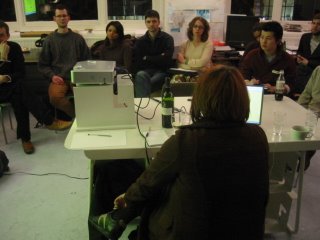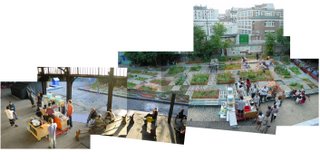Friday, December 08, 2006
GOOD INSIGHT

Thanks to Doina and Constantin from aaa architecs to allow us an insight into the development and decission making processes of some of their projects. The term Pragmatist Imagination comes to mind to describe their political pragmatic approach that believes in the possibility to improve things whilst remaining informal and playful.
Monday, December 04, 2006
COMMENTS ON PICTOPLASMA FRIDAY SESSION

We wanted to take this opportunity to briefly thank Pictoplasma and Lars Denicke to make his way over to London for last Friday's session.
The evening attracted a mix of people with some being very familiar to the subject of 'character design' and others only attracted by curiousity. Lars is one of the two founders of Pictoplasma, based in Berlin, and together with his business associate, Peter they were one of the first to recognise and proclaim the development of a new species of characters that surmount cultural barriers and celebrate the possibilities of a universal language. If people were wondering before they arrived at last Friday's talk, with his presentation about Pictoplasma's work and the 2- and 3 dimensional characters becoming animated and starting to inhabit our cities with their own lives, Lars raised astonishment even further. The question about the future of 'characters', should they be (fully) commercialised, as in the instance of the ads for Opel/Vauxhaul, or should they return to their initial 2-dimensional flatness, remains to be explored by Pictoplasma and all the character lovers and their community.
Special thanks to the colourful characters and the numerous children who turned this into a really lively Friday session.
Friday, December 01, 2006
FS10 ON TUESDAY 5 DEC at 19.00 WITH DOINA PETRESCU AND CONSTANTIN PETCOU

Doina Petrescu and Constantin Petcou will present and discuss the work of atelier d’architecture autogérée (aaa) in Paris. She is also a lecturer in architecture at the University of Sheffield and a co editor of the recently published "Architecture&Participation" book.
" The atelier d’architecture autogérée / studio of self-managed architecture (aaa) is a collective platform which conducts actions and research concerning urban mutations and cultural, social and political emerging practices in the contemporary city. The interdisciplinary network was founded in 2001 in Paris by architects, artists, students, researchers, unemployed persons, activists and residents.
We develop urban tactics to accompany micro-processes and enable rifts within the standardised urban contexts, which are regulated by private economic interests or centralised policies. These policies are incompatible with the global, informal and multicultural mobilities that characterise the present-day metropolis. We encourage the re-appropriation of derelict spaces and the creation of new forms of urbanity by local residents through reversible designs and lived everyday practices, which make use of their skills and knowledge. These spaces conserve a potential of accessibility and experimentation by resisting the increasing control of the urban context.
Our approach involves not only critical analysis but also the process of making and acting through shared competencies and collaborations. We valorise the position of the resident/user as political condition
and develop tools cooperatively to re-territorialise their spaces of proximity and empower their decisions and actions within the city. These tools include among others trans-local networks, catalyst processes, nomad architectures, self-managed spaces and platforms for cultural production.
A “self-managed architecture” provokes assemblages and networks of individuals, desires and different manners of making. It is a relational practice, which is not always consensual but at times conflictual, and it is the role of the architect to locate confrontations and accompany subjective productions. Such an architecture does not correspond to a liberal practice but asks for new forms of association and collaboration, based on exchange and reciprocity.
Our architecture is simultaneously political and poetic as it aims above all to “create relationships between worlds”.
